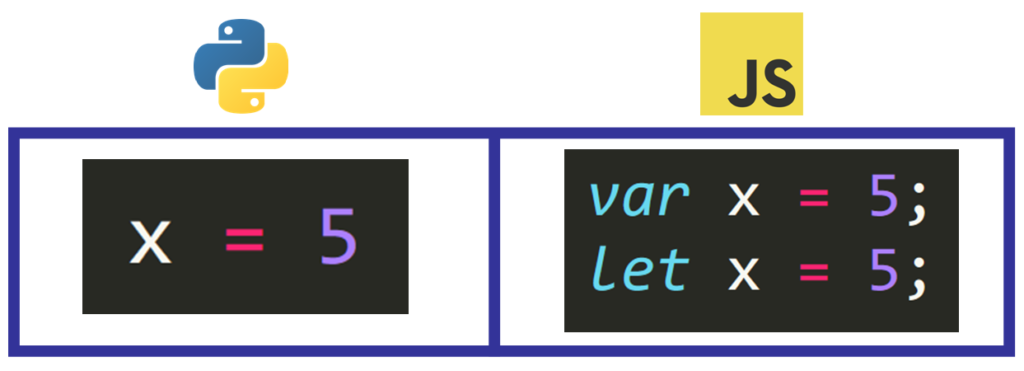While JavaScript and Python are both popular, high-level programming languages, they serve different purposes and have distinct features. However, they do share some similarities, which can make learning one of them easier if you’re familiar with the other.
Here’s a breakdown of their similarities and differences:
Similarities Between JavaScript and Python
- High-Level and Interpreted Languages
- Both JavaScript and Python are high-level languages, meaning they are abstracted from the machine’s hardware and are easier for humans to read and write.
- Both languages are interpreted, meaning the code is executed directly by an interpreter, rather than being compiled into machine code first (though Python can be compiled into bytecode).
- Dynamic Typing
- Both JavaScript and Python are dynamically typed, meaning you don’t need to explicitly declare the types of variables. The type is inferred at runtime.
- Exercise in both languages:

#javascript
let x = 10; // JavaScript
#python
x = 10 # Python

3. Support for Object-Oriented Programming (OOP)
- Both languages support object-oriented programming, allowing you to create and work with classes and objects.
- JavaScript uses prototype-based inheritance, while Python uses class-based inheritance, but both can define and use classes and objects.
4. First-Class Functions
- In both languages, functions are first-class citizens, meaning they can be assigned to variables, passed as arguments, and returned from other functions.
5. Cross-Platform
- Both JavaScript and Python are cross-platform, meaning code written in either language can be run on different operating systems (Windows, macOS, Linux) without modification.
6. Wide Use in Web Development
- Both languages play major roles in web development:
- JavaScript is the primary language for front-end (client-side) web development.
- Python is commonly used for back-end development, especially with frameworks like Django and Flask.
Key Differences Between JavaScript and Python
- Primary Use Cases
- JavaScript is primarily used for web development, specifically for client-side scripting to create interactive websites. It also has strong use cases on the server-side through Node.js.
- Python is a general-purpose programming language used in a wide variety of fields, including web development (backend), data science, machine learning, automation, and scripting.
- Syntax
- Python is known for its clean, readable syntax, which is designed to be easy for beginners. Python uses indentation to define blocks of code, which makes the structure of the program clear.
- JavaScript has a C-like syntax, using curly braces
{}to define code blocks, which is more common in languages like C, C++, or Java.
- Python:
#python
if x > 10:
print("x is greater than 10")
- JavaScript:
#javascript
if (x > 10) {
console.log("x is greater than 10");
}
- Execution Environment
- JavaScript is primarily executed in the browser (client-side), though it can also run on the server using Node.js.
- Python is usually run as a script on a local machine or server. Python code is executed using the Python interpreter.
- Concurrency and Asynchronous Programming
- JavaScript is built for handling asynchronous tasks, especially in the context of web development, with features like callbacks, promises, and async/await.
- Python also supports asynchronous programming with libraries like asyncio, but it’s not as integral to the language as it is in JavaScript, especially for web development.
- Libraries and Ecosystem
- JavaScript has a vast ecosystem of libraries and frameworks for web development, such as React, Vue.js, Angular, and Express.
- Python is known for its strength in areas like data science, machine learning, automation, and scripting, with popular libraries like NumPy, Pandas, TensorFlow, and Django.
Which One to Learn?
- JavaScript is essential for anyone who wants to work in web development, especially for front-end development, but also for full-stack development with Node.js.
- Python is great for beginners due to its easy-to-understand syntax and is incredibly versatile, making it suitable for web development, data science, automation, and more.
Note:
JavaScript and Python are both powerful and widely-used languages, but they are not identical. They have different primary use cases, syntaxes, and execution environments, with JavaScript being focused on web development (especially on the client-side) and Python being more versatile across different domains. However, both languages are beginner-friendly, dynamically typed, and feature rich ecosystems, which makes them great choices for developers.




